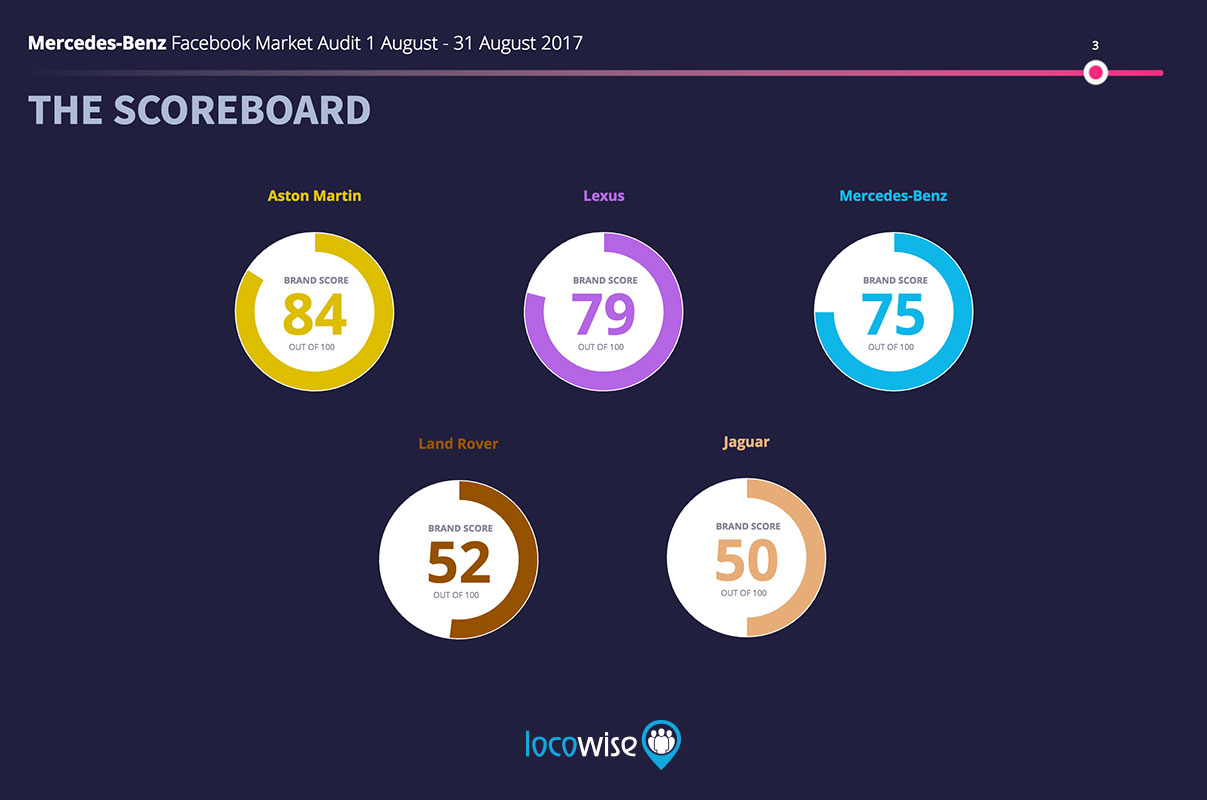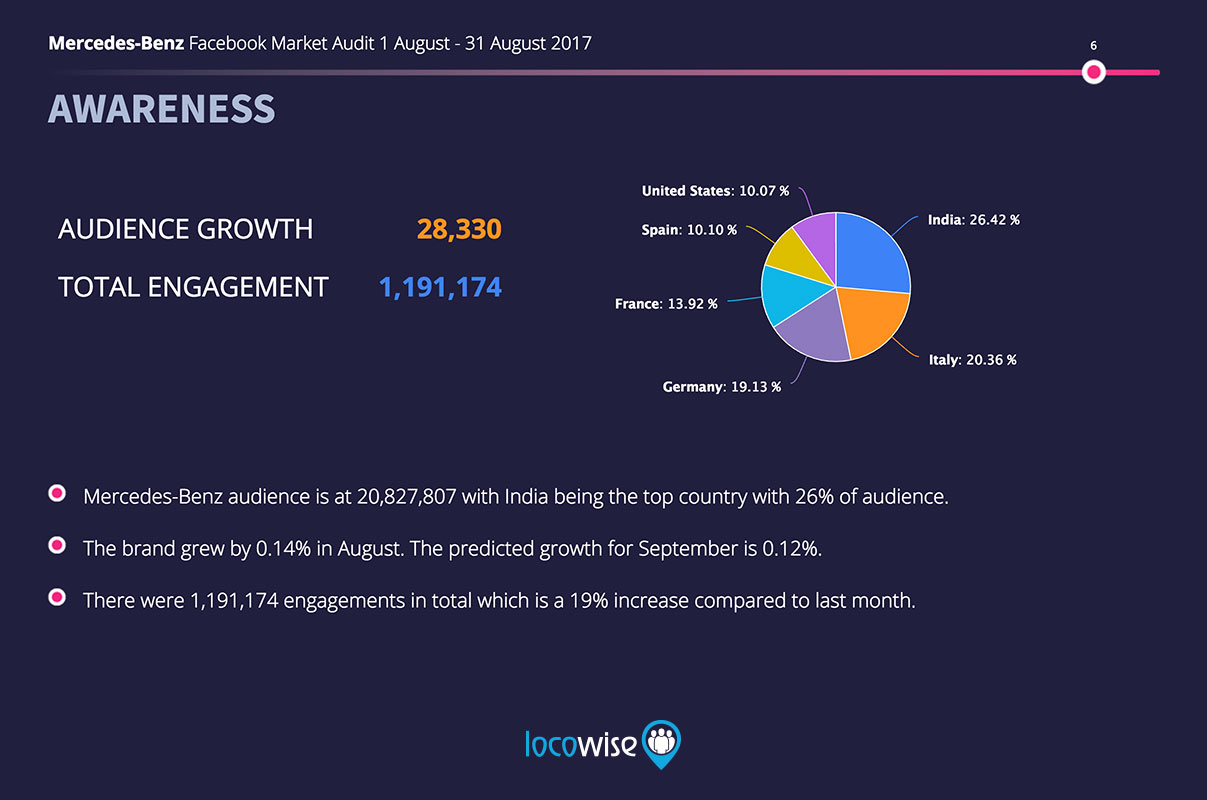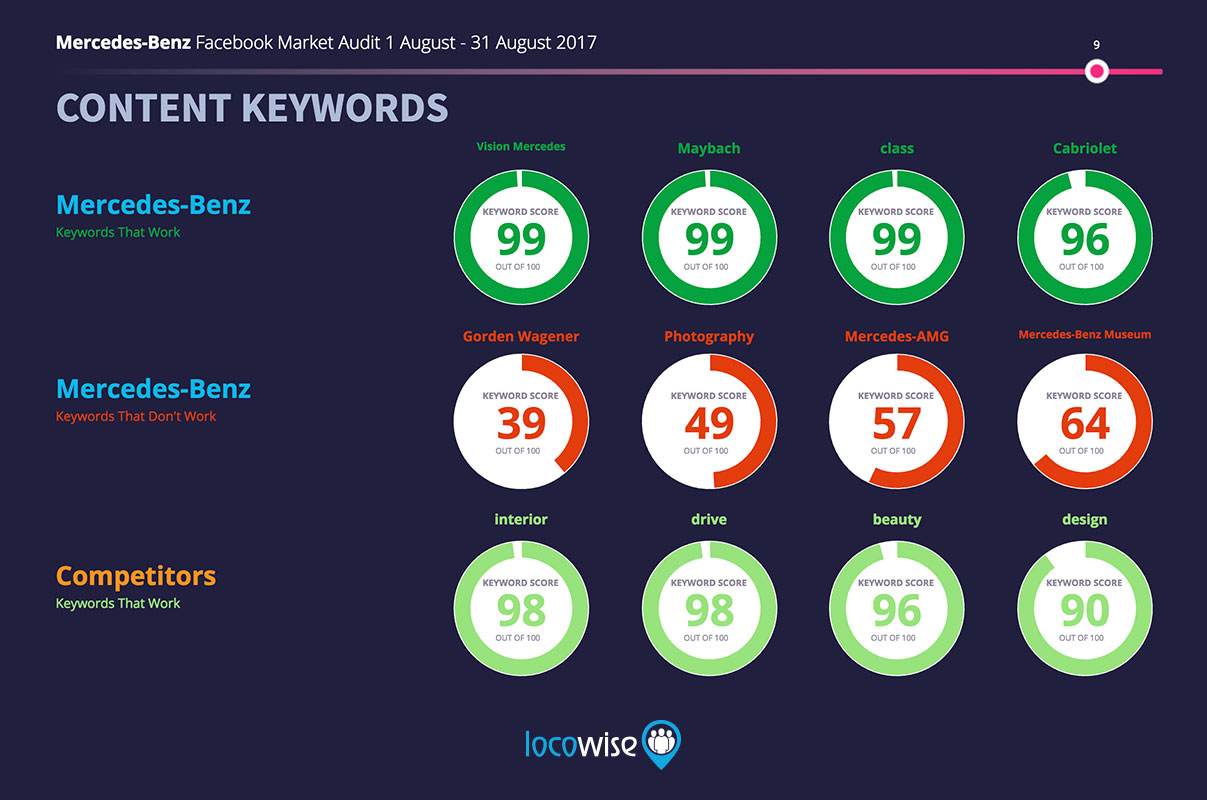Top 5 Best Luxury Car Brands On Facebook
Sahail Ashraf posted on 18 September 2017
Luxury automobile companies have never really been slow on the uptake with social media, well the big brands haven’t anyway. And if you took a look at any of the big brands on Facebook, Instagram and so on, you would see clear voices and an informed approach to social media.
They seem to know what they are doing. However, every brand fight needs at least one frontrunner. We are going to take a look at a few big players in this fast moving industry and see what they are doing to remain ahead of the game.
Using our Market Audit, we focused on the performance in August 2017. We thought we would look at Mercedes-Benz as the primary brand. Its Facebook page is perhaps the flagship for the brand in regards to their social media presence. It is full of the kind of content we expect from a brand that has a clear knowledge of the market it is in.

On Facebook, it continues to push the envelope and it has a number of fans to accommodate too. This is no pushover, even if you are sitting on a brand that has been successful for well over a century. Taking a look at Mercedes as the primary brand in our Market Audit, we find that the huge follower base is loyal and engaged in what the brand has to say.
Here’s the complete Mercedes-Benz Market Audit For August 2017.
The market Mercedes-Benz operates in
Mercedes has a healthy position in the market. We looked at four other brands with a view to comparing them with Mercedes-Benz. The four brands are carmakers that fit into the same luxury bracket that Mercedes does.
Still affordable but significantly more expensive than the average saloon, basically. These brands (all five of them) produce vehicles that are aspirational. At the same time, they aren’t vehicles that are completely beyond the average person.
The brands are:
Mercedes-Benz
Aston Martin
Lexus
Land Rover
Jaguar
We looked at all the Facebook pages and found that the landscape has a total of 33,721,672 followers in it. The very best piece of news here for Mercedes-Benz is that it has a rather significant share of that combined follower base. The brand has 62% of the total audience here, something it can easily capitalise on through strong engagement.

Our Market Audit also shows that the posting activity Mercedes-Benz is coming up with is nothing to be sniffy about. Out of that competitive landscape, Mercedes-Benz accounted for 42% of the total number of new posts in August.
This, and the share of that vast market, should translate into a successful month, in theory. But audience share and frequency of posts doesn’t always make for the most popular brand in terms of engagement. And on Facebook, there is still some work to do for Mercedes.
But we will get to that shortly. Let’s drill down into what Mercedes-Benz achieved in August first of all.
August for Mercedes
The summer is not always the best time for brands on social with so many people being out of their usual routines. But Mercedes had a good August on Facebook, and a positive one compared to July.
Our Market Audit shows that the brand understands the benefits of healthy posting numbers. The total number of posts on the page in August was 108. Of that number, 61 posts were video based. The number of posts overall showed a 26% increase compared to July.
However, the engagement rate per post was a little lower than it was in July. So we have a situation where posts increased in number, but post engagement rate went down. To be exact, there was an engagement rate, on average, of 0.5% per post. This is a disappointing 11% lower than in July. But the total number of engagements overall was 19% higher than July.

Quite importantly, Mercedes not only has a large share of the audience, it also has strong positive sentiment. It doesn’t have the best sentiment of the five brands according to our Market Audit, but it has a score of 97%. This is only beaten by two other brands in our market sample, Aston Martin and Lexus, with 99% being the score for both brands.
Content that works and content that doesn’t
Two of the content keywords that are not working for the brand are ‘Mercedes-AMG’ and ‘Mercedes Benz Museum’. Now these present a particular problem. The car model is a popular one, but obviously the keyword is not bringing in much engagement on Facebook. There was clearly a key post about the museum, but that doesn’t work for the audience.
However, what is most interesting is the set of keywords that are working for competitors. These are words like ‘interior’, ‘beauty’ and ‘design’. These are all pretty general terms for the industry, but if Mercedes-Benz wanted to ensure their posts receive more reach and engagement on Facebook, it might be worth investigating the use of these keywords and creating posts about them.
What we find quite telling is the work that Lexus is doing. In August, the post that received the most engagement for this brand simply engaged with the audience. Showing a photo of a desirable car, the post asked ‘In five words or less, tell us what you would do with this TOM’S Racing X #Lexus RCF collaboration for the weekend’. This post gained 1,361 comments, which is 304% more comments than Mercedes-Benz achieved for their August 2017 posts on average.
Obviously, this kind of comparison rests on understanding that Mercedes does gain an awful lot of reach and engagement. But what’s important here is the concept of Lexus doing better with a carefully created and delivered (hashtags and all, which helps) post that asks the audience to get involved.

And an Aston Martin post gained 74% more likes than an average Mercedes post for another interactive piece which asked the audience to take the opportunity to ‘design your own masterpiece’.
The outcome
It’s a large market for these brands, and Mercedes-Benz has a big chunk of that market. But to take it to the next level, it needs to take note of the playbook for Aston Martin, for example. That brand is gaining more engagement, on average, than Mercedes.
If Mercedes-Benz was to lose its position in this market anytime soon, we would be most surprised. But sowing the seeds for the future is vital. The sentiment is higher with two of the rival brands and that again shows that valuable work can still be done to move forward.
If we were to stick our necks out even further, we would say the brand has to focus on content keywords and topics that are more effective, and start talking to the audience and deliberately creating content that fans feel compelled to respond to.
We are still looking at a huge brand here, but enhancing what is done will show better results. We would crank out a few more engagement rich posts, and see what the outcome will be in September.
Need to get clear and accessible metrics done for a client? Use the same technology that is used in this article to investigate what is working and what is not. Take a free 7 day trial of Locowise, and see where your brand is in its own market.



